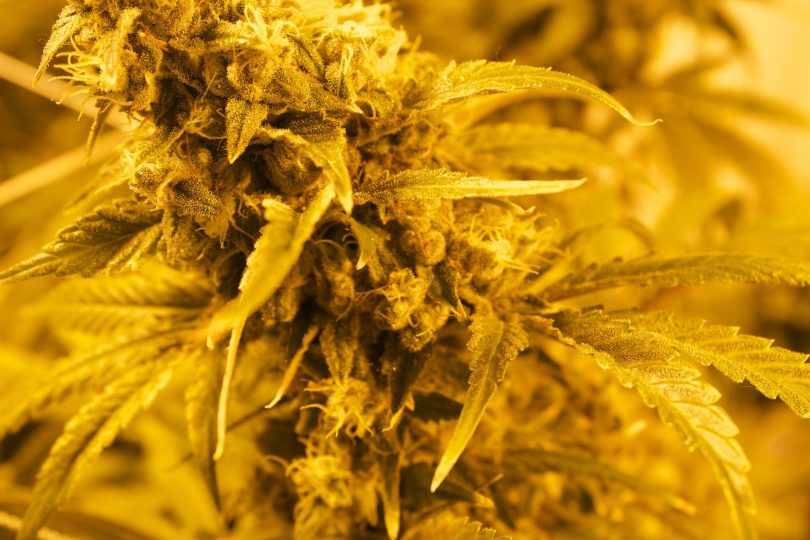Delta-9-tetrahydrocannabinol (THC) polarizes cultivators. Medicinal cannabis growers usually seek to maximize THC content. Hemp farmers must minimize THC as a matter of law. Strategies to control THC are therefore paramount in cannabis cultivation. One variable is stress. Stressful environmental conditions may cause Cannabis sativa L. plants to boost production of THC and other cannabinoids, such as cannabidiol (CBD).
One recent study applied controlled drought to flowering cannabis plants. [1] The researchers withheld fertigation for 11 days starting at week 7 of the flowering period. This increased tetrahydrocannabinolic acid (THCA) by 12% and cannabidiolic acid (CBDA) by 13% compared to the well-irrigated control. THC and CBD yields per unit growing area were 50% and 67% higher, respectively. [1] For hemp farmers, this means that even short periods of drought or insufficient fertilization may push THC beyond the 0.3% legal threshold.
Another example is ultraviolet-B (UV-B) radiation, which can easily destroy plants in sufficient quantities. But in small amounts during flowering, UV-B light boosts THC accumulation in cannabis, an act of self-protection reminiscent of sunscreen. [2,3]
Mansouri et al [4] applied abscisic acid (ABA), a sesquiterpene that acts as a plant hormone, to flowering cannabis plants. ABA inhibits growth and is produced by plants in response to environmental stressors, including (but not limited to) drought, UV radiation, cold, and salinity. [5] After exogenous application to cannabis, the researchers noted increased THC and α-tocopherol but decreased chlorophyll, carotenoids, and phytosterols. [4]
It thus appears that stress promotes THC production. But hemp farmers are not necessarily at the mercy of the elements. As noted in a 2020 investigation, cultivators who secure seed genetics with two CBDA synthase alleles (rather than the more common combination of a CBDA synthase allele and a THCA synthase allele) may eliminate THC spikes. [4] This strategy targets the plant at the genetic level to avoid any possibility of THC production. It is unclear how (or if) stress boosts CBD and other legal cannabinoids in plants lacking the THCA synthase allele.
THC and other cannabinoids are plant defense mechanisms, and cannabis responds to environmental stress with decisive chemical action. But it’s a fine balance. Too much stress or stress at the wrong time may damage or kill plants. Plant genetics also modulate these responses.
References
- Caplan, D, et al. “Increasing Inflorescence Dry Weight and Cannabinoid Content in Medical Cannabis Using Controlled Drought Stress.” HortScience, vol. 54, May 2019, pp. 964–69, doi:10.21273/HORTSCI13510-18. [Journal Impact Factor = 0.936; Times Cited = 1]
- Lydon J, et al. “UV-B Radiation Effects on Photosynthesis, Growth and Cannabinoid Production of Two Cannabis Sativa Chemotypes.” Photochemistry and Photobiology, 1987, Volume 46, no.2, pp.201-206. [Times Cited = 51; Journal Impact Factor = 2.338]
- Eichhorn Bilodeau, S, et al. “An Update on Plant Photobiology and Implications for Cannabis Production.” Frontiers in Plant Science, vol.10, 2019, p.296, https://www.frontiersin.org/article/10.3389/fpls.2019.00296. [Journal Impact Factor = 4.298; Times Cited = 3;]
- Mansouri, H, et al. “Effects of ABA on Primary Terpenoids and Δ 9 -Tetrahydrocannabinol in Cannabis Sativa L. at Flowering Stage.” Plant Growth Regulation, vol.58, 2009, pp.269–77, doi:10.1007/s10725-009-9375-y. [Journal Impact Factor = 2.473; Times Cited = 25]
- Finkelstein, R. “Abscisic Acid Synthesis and Response.” The Arabidopsis Book,11 no.e0166, 2013, doi:10.1199/tab.0166. [Times Cited = 414]
- Toth, J, et al. “Development and Validation of Genetic Markers for Sex and Cannabinoid Chemotype in Cannabis Sativa L.” GCB Bioenergy, vol.12, 2020, doi:10.1111/gcbb.12667. [Journal Impact Factor = 4.849; Times Cited = 1]








